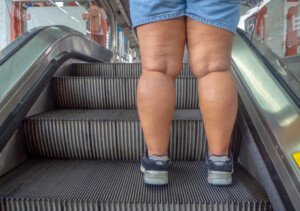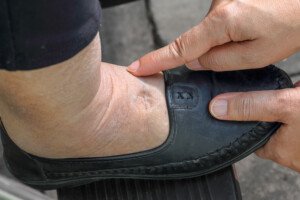
Excess body fat causes edema, but so does chronic heart failure.
Here is a comparison in how this swelling looks on the body when it’s caused by either of these two common conditions.
When a person has excess body fat, what makes them big is the enlargement of fat cells.
A person’s legs can be quite big from excess body fat. Sometimes this fat can look edematous: consisting of edema.
When a thin person has edema from chronic heart failure, it’s very obvious. An overweight person, too, can have edema from heart failure.
And then there are overweight people who don’t have heart failure but fear that they do because they think there’s edema in their legs and even belly.
Does the edema from being fat look different than the edema from chronic heart failure?
“Edema from heart failure is a collection of fluid under the skin which is primarily located in dependent (lower) portions of the body, especially the ankles and legs,” says Morton Tavel, MD, Clinical Professor Emeritus of Medicine, Indiana University School of Medicine, and author of “Health Tips, Myths and Tricks: A Physician’s Advice.”
“It results from increased pressure in the veins enhanced by gravity in the presence of impaired ability of the heart to clear blood from these lower bodily veins, and as a result, the fluid components of the blood leak out into surrounding tissues,” explains Dr. Tavel.
“Edema from heart failure is usually manifest as a puffiness in the ankles, which is ‘pitting’ in nature, i.e., light pressure by the fingers leaves small pits in the skin remaining for a short time after the pressure is released.”

Shutterstock/Toa55
Edema from chronic heart failure often appears worse at night.
“Despite a similar appearance, this characteristic usually allows its distinction from ‘puffiness’ resulting from fat under the skin found in obese people,” continues Dr. Tavel.
“This latter type of swelling does not ‘pit’ in response to external pressure, since the pitting [from heart failure] results from fluid that has escaped into the surrounding tissues.
“Moreover, puffiness in the obese may extend to all portions of the body, not just the lower extremities.” Further, it won’t look worse at night.
Pitting from Other Causes
Dr. Tavel explains, “Occasionally, however, obese people — and occasionally those who are not obese — will exhibit swelling that does pit, which may result from buildup of pressure in the veins of the legs after prolonged sitting or standing.
“In this latter instance, however, additional signs of heart failure, such as shortness of breath on exertion or evidence of reduced heart function on various testing means [namely, an echocardiogram], are absent. Neither type of swelling is typically associated with pain.”

Dr. Tavel’s medical research includes over 125 publications, editorials and book reviews in peer-reviewed national medical journals. He was formerly director of the cardiac rehabilitation program at St. Vincent Hospital in Indiana. mortontavel.com
 Lorra Garrick has been covering medical, fitness and cybersecurity topics for many years, having written thousands of articles for print magazines and websites, including as a ghostwriter. She’s also a former ACE-certified personal trainer.
Lorra Garrick has been covering medical, fitness and cybersecurity topics for many years, having written thousands of articles for print magazines and websites, including as a ghostwriter. She’s also a former ACE-certified personal trainer.
.











